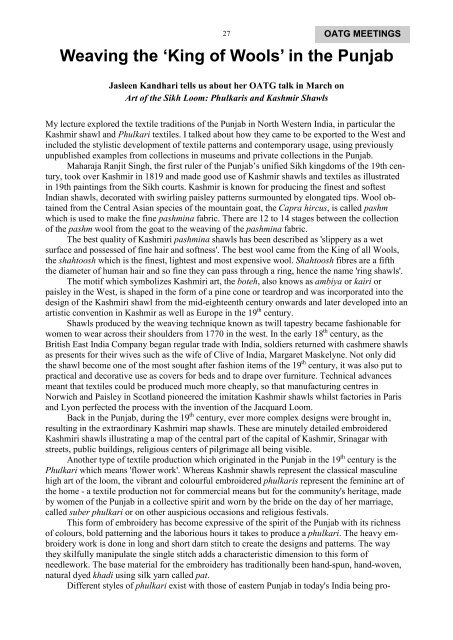ASIAN TEXTILES - OATG. Oxford Asian Textile Group
ASIAN TEXTILES - OATG. Oxford Asian Textile Group
ASIAN TEXTILES - OATG. Oxford Asian Textile Group
You also want an ePaper? Increase the reach of your titles
YUMPU automatically turns print PDFs into web optimized ePapers that Google loves.
27 <strong>OATG</strong> MEETINGSWeaving the ‘King of Wools’ in the PunjabJasleen Kandhari tells us about her <strong>OATG</strong> talk in March onArt of the Sikh Loom: Phulkaris and Kashmir ShawlsMy lecture explored the textile traditions of the Punjab in North Western India, in particular theKashmir shawl and Phulkari textiles. I talked about how they came to be exported to the West andincluded the stylistic development of textile patterns and contemporary usage, using previouslyunpublished examples from collections in museums and private collections in the Punjab.Maharaja Ranjit Singh, the first ruler of the Punjab’s unified Sikh kingdoms of the 19th century,took over Kashmir in 1819 and made good use of Kashmir shawls and textiles as illustratedin 19th paintings from the Sikh courts. Kashmir is known for producing the finest and softestIndian shawls, decorated with swirling paisley patterns surmounted by elongated tips. Wool obtainedfrom the Central <strong>Asian</strong> species of the mountain goat, the Capra hircus, is called pashmwhich is used to make the fine pashmina fabric. There are 12 to 14 stages between the collectionof the pashm wool from the goat to the weaving of the pashmina fabric.The best quality of Kashmiri pashmina shawls has been described as 'slippery as a wetsurface and possessed of fine hair and softness'. The best wool came from the King of all Wools,the shahtoosh which is the finest, lightest and most expensive wool. Shahtoosh fibres are a fifththe diameter of human hair and so fine they can pass through a ring, hence the name 'ring shawls'.The motif which symbolizes Kashmiri art, the boteh, also knows as ambiya or kairi orpaisley in the West, is shaped in the form of a pine cone or teardrop and was incorporated into thedesign of the Kashmiri shawl from the mid-eighteenth century onwards and later developed into anartistic convention in Kashmir as well as Europe in the 19 th century.Shawls produced by the weaving technique known as twill tapestry became fashionable forwomen to wear across their shoulders from 1770 in the west. In the early 18 th century, as theBritish East India Company began regular trade with India, soldiers returned with cashmere shawlsas presents for their wives such as the wife of Clive of India, Margaret Maskelyne. Not only didthe shawl become one of the most sought after fashion items of the 19 th century, it was also put topractical and decorative use as covers for beds and to drape over furniture. Technical advancesmeant that textiles could be produced much more cheaply, so that manufacturing centres inNorwich and Paisley in Scotland pioneered the imitation Kashmir shawls whilst factories in Parisand Lyon perfected the process with the invention of the Jacquard Loom.Back in the Punjab, during the 19 th century, ever more complex designs were brought in,resulting in the extraordinary Kashmiri map shawls. These are minutely detailed embroideredKashmiri shawls illustrating a map of the central part of the capital of Kashmir, Srinagar withstreets, public buildings, religious centers of pilgrimage all being visible.Another type of textile production which originated in the Punjab in the 19 th century is thePhulkari which means 'flower work'. Whereas Kashmir shawls represent the classical masculinehigh art of the loom, the vibrant and colourful embroidered phulkaris represent the feminine art ofthe home - a textile production not for commercial means but for the community's heritage, madeby women of the Punjab in a collective spirit and worn by the bride on the day of her marriage,called suber phulkari or on other auspicious occasions and religious festivals.This form of embroidery has become expressive of the spirit of the Punjab with its richnessof colours, bold patterning and the laborious hours it takes to produce a phulkari. The heavy embroiderywork is done in long and short darn stitch to create the designs and patterns. The waythey skilfully manipulate the single stitch adds a characteristic dimension to this form ofneedlework. The base material for the embroidery has traditionally been hand-spun, hand-woven,natural dyed khadi using silk yarn called pat.Different styles of phulkari exist with those of eastern Punjab in today's India being pro-
















